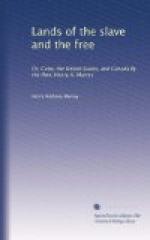Let two examples suffice, both of which I have upon the very best authority. A faithful slave, having grown up with his master’s rising family, obtained his freedom as a reward for his fidelity, and was entrusted with the management of the property; realizing some money, he became the owner of slaves himself, from among whom he selected his wife, and to all of whom he showed the greatest consideration. Some time after, lying upon his deathbed, he made his will, in which he bequeathed his wife and all his other negroes to his old master, giving as his reason, that, from his own lively recollections of his master’s unvarying kindness to himself and the other slaves, he felt certain that in so doing he was taking the best means in his power of securing their future happiness. What stronger evidence of the growth of kindness in the master’s heart could possibly be desired? Here, then, is the effect of habit in a benevolent owner.—Now, turn to the opposite picture. A lady of New Orleans was accustomed to strip and flog a slave for the pleasure of witnessing sufferings which she endeavoured to render more acute by rubbing soft soap into the broken skin. Here you have the effect of habit upon a brutal mind.
To the credit of New Orleans be it recorded, that the knowledge of this atrocity having come to white ears, her house was broken open, every article it contained pulled out in the street and burnt, and, had she not succeeded in eluding search, the she-devil would have been most assuredly reduced to ashes with her own goods. America became too hot for her, and Providence alone knows the demon’s cave of concealment.
Having thus passed in review the various influences bearing upon the treatment of the slave, and seen how utterly inadequate they are to protect him from ill-treatment, who can wonder that the tales of real or supposed cruelty inflicted upon slaves by the Southerners are received with indignation by both parties in the States?—the virtuous and kind master, indignant at the thought of being included in the category of monsters, and the real savage, if possible, still more indignant, because his conscience brings home to his seared heart the truthfulness of the picture, even if it be overdrawn almost to caricature. And here it is curious to observe the different action of these two parties: the former, in the consciousness of a kind heart and a real desire for the negro’s good, calmly states what has been done and is doing for the negro, and throws a natural veil of doubt over horrors so utterly repulsive to the feelings that their existence is discredited; the latter, with a shallowness which Providence sometimes attaches to guilt, aware that some such accusations come too painfully and truthfully home, pronounce their own condemnation by their line of defence—recrimination.
Take, for example, the following extract from an article in a Slave State paper, entitled “A Sequel to Uncle Tom’s Cabin,” and in which Queen Victoria, under the guidance of a “genius,” has the condition of her subjects laid bare before her. After various other paragraphs of a similar nature comes the following:—




